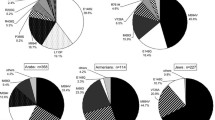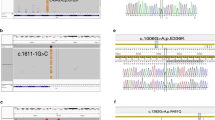Abstract
The aim of the present study was to evaluate the clinical features of childhood-onset Familial Mediterranean fever (FMF) patients and to assess the phenotype–genotype correlation. The study included patients with childhood-onset FMF that followed up over a period of 18 years in the Division of Pediatric Allergy and Immunology clinic. Twelve MEFV mutations were investigated in all patients. The patients were classified into four groups according to mutations: 1, M694V homozygote; 2, M694V heterozygote; 3, compound heterozygote for M694V; and 4, other-other gene mutation group. The following parameters were evaluated: gender, age of onset, age at diagnosis, time interval between disease onset and diagnosis, fever, abdominal pain, chest pain, arthralgia, arthritis, myalgia, vomiting, diarrhea, constipation, headache, erysipela-like erythema, protracted febrile myalgia, splenomegaly, hepatomegaly, consanguinity, number of attacks before and after treatment, severity score, response to colchicine treatment. Of the 124 patients included in the study, 105 had at least one MEFV gene mutation. M694V homozygosity was the most common mutation, followed by M694V heterozygotes and M694V—M680I compound heterozygotes. Severity score was found significantly higher in patients with M694V homozygote and compound heterozygote for M694V compared with other groups. The data supported the findings in literature that FMF patients with M694V homozygote and compound heterozygote for M694V gene mutations experience a more severe clinical course.
Similar content being viewed by others
References
Sohar E, Gafni J, Pras M et al (1967) Familial Mediterranean fever: a survey of 470 cases, and review of the literature. Am J Med 43:227–253. doi:10.1016/0002-9343(67)90167-2
Barakat MH, Kamik AM, Majeed HW et al (1986) Familial Mediterranean fever (recurrent hereditary polyserositis) in Arabs. A study of 175 patients and review of the literature. Q J Med 60:837–846
Saatci U, Ozen S, Ozdemir S et al (1997) Familial Mediterranean fever in children: report of a large series and discussion of the risk and prognostic factors of amyloidosis. Eur J Pediatr 156:619–623. doi:10.1007/s004310050677
French FMF Consortium (1997) A candidate gene for Familial Mediterranean fever. Nat Genet 17:25–31. doi:10.1038/ng0997-25
International FMF Consortium (1997) Ancient missense mutations in a new member of the Roret gene family are likely to cause Familial Mediterranean fever. Cell 90:797–807. doi:10.1016/S0092-8674(00)80539-5
Touitou I (2003) Standardized testing for mutations in Familial Mediterranean fever. Clin Chem 49:1781–1782. doi:10.1373/clinchem.2003.025791
Mansfield E, Chae JJ, Komarow HD et al (2001) The Familial Mediteranean fever protein, pyrin, associates with microtubules and colocalizes with actin filaments. Blood 98:851–859. doi:10.1182/blood.V98.3.851
Papin S, Cuenin S, Agostini L et al (2007) The SPRY domain of Pyrin, mutated in Familial Mediterranean fever patients, interacts with inflammasome components and inhibits proIL-1beta processing. Cell Death Differ 14:1457–1466. doi:10.1038/sj.cdd.4402142
Masumoto J, Dowds TA, Schaner P et al (2003) ASC is an activating adaptor for NF-kappa B and caspase-8-dependent apoptosis. Biochem Biophys Res Commun 303:69–73. doi:10.1016/S0006-291X(03)00309-7
Koné Paut I, Dubuc M, Sportouch J et al (2000) Phenotype–genotype correlation in 91 patients with Familial Mediterranean fever reveals a high frequency of cutaneomucous features. Rheumatology 39:1275–1279. doi:10.1093/rheumatology/39.11.1275
Dewalle M, Domingo C, Rozenbaum M et al (1998) Phenotype–genotype correlation in Jewish patients suffering from Familial Mediterranean fever. Eur J Hum Genet 6:95–97. doi:10.1038/sj.ejhg.5200170
Sayhan N, Ozdogan H, Kasapcopur O et al (2000) MEFV gene analysis in Familial Mediterranean fever patients from Turkey: prognostic value of M694V homozygous phenotype. Clin Exp Rheumatol 18:286 Abstract
Yilmaz E, Ozen S, Balci B et al (2001) Mutation frequency of Familial Mediterranean fever and evidence for a high carrier rate in the Turkish population. Eur J Hum Genet 9:553–555. doi:10.1038/sj.ejhg.5200674
Ozen S, Karaaslan Y, Ozdemir O et al (1998) Prevalence of juvenile chronic arthritis and Familial Mediterranean fever in Turkey: a field study. J Rheumatol 25:2445–2449
Dinc A, Pay S, Turan M et al (2000) Prevalence of Familial Mediterranean fever in young Turkish men. Clin Exp Rheumatol 18:292 abstract
Livneh A, Langevitz P, Zemer D et al (1997) Criteria for the diagnosis of Familial Mediterranean fever. Arthritis Rheum 40:1879–1885. doi:10.1002/art.1780401023
Sohar E, Gafni J, Pras M (1997) Tel Hashomer key to severity score for FMF. In: Sohar E, Gafni J, Pras M (eds) Proceedings of the first ınternational conference of FMF. Freud Publishing House, Tel Aviv, p 208
Miller SA, Dykes DD, Polesky HF (1988) A simple salting out procedure for extracting DNA from human nucleated cells. Nucleic Acids Res 16:1215. doi:10.1093/nar/16.3.1215
Kriegshauser G, Weinhausel A, Haas OA et al (2002) Molecular genetic diagnosis of Familial Mediterranean fever by PCR and reverse-hybridization. Clin Exp Rheumatol 20:86
Al-Alami JR, Tayeh MK, Najib DA et al (2003) Familial Mediterranean fever mutation frequencies and carrier rates among a mixed Arabic population. Saudi Med J 24:1055–1059
Majeed HA, El-Khateeb M, El-Shanti H et al (2005) The spectrum of Familial Mediterranean fever gene mutations in arabs: report of a large series. Semin Arthritis Rheum 34:813–818. doi:10.1016/j.semarthrit.2005.01.010
Dode C, Pecheux C, Cazeneuve C et al (2000) Mutations in the MEFV gene in a large series of patients with a clinical diagnosis of Familial Mediterranean fever. Am J Med Genet 92:241–246. doi:10.1002/(SICI)1096-8628(20000605)92:4<241::AID-AJMG3>3.0.CO;2-G
Medlej-Hashim M, Rawashdeh M, Chouery E et al (2000) Genetic screening of fourteen mutations in Jordanian Familial Mediterranean fever patients. Hum Mutat 15:384. doi:10.1002/(SICI)1098-1004(200004)15:4<384::AID-HUMU19>3.0.CO;2-U
Mattit H, Joma M, Al-Cheikh S et al (2006) Familial Mediterranean fever in the Syrian population: gene mutation frequencies, carrier rates and phenotype–genotype correlation. Eur J Med Genet 49:481–486. doi:10.1016/j.ejmg.2006.03.002
Yalcinkaya F, Cakar N, Misirlioglu M et al (2000) Genotype–phenotype correlation in a large group of Turkish patients with Familial mediterranean fever: evidence for mutation-independent amyloidosis. Rheumatology 39:67–72. doi:10.1093/rheumatology/39.1.67
Cazeneuve C, Sarkisian T, Pecheux C et al (1999) MEFV-gene analysis in armenian patients with Familial Mediterranean fever: diagnostic value and unfavorable renal prognosis of the M694V homozygous genotype-genetic and therapeutic implications. Am J Hum Genet 65:88–97. doi:10.1086/302459
Padeh S, Shinar Y, Pras E et al (2003) Clinical and diagnostic value of genetic testing in 216 Israeli children with Familial Mediterranean fever. J Rheumatol 30:185–190
Akar N, Misiroglu M, Yalcinkaya F et al (2000) MEFV mutations in Turkish patients suffering from Familial Mediterranean fever. Hum Mutat 15:118–119. doi:10.1002/(SICI)1098-1004(200001)15:1>118::AID-HUMU29<3.0.CO;2-5
Ertekin V, Selimoglu MA, Pirim I (2005) Familial Mediteranean fever in a childhood population in eastern Turkey. Pediatr Int 47:640–644. doi:10.1111/j.1442-200x.2005.02140.x
Touitou I (2001) The spectrum of Familial Mediterranean fever (FMF) mutations. Eur J Hum Genet 9:473–483. doi:10.1038/sj.ejhg.5200658
Sabbagh AS, Ghasham M, Khalek RA et al (2008) MEFV gene mutations spectrum among Lebanese patients referred for Familial Mediterranean fever work-up: experience of a major tertiary care center. Mol Biol Rep 35(3):447–451
Yilmaz E, Balci B, Kutlay S et al (2003) Analysis of the modifying effects of SAA1, SAA2 and TNF-alpha gene polymorphisms on development of amyloidosis in FMF patients. Turk J Pediatr 45:198–202
Sayarlıoglu M, Cefle A, Inanc M et al (2005) Characteristics of patients with adult onset Familial Mediterranean fever in Turkey: analysis of 401 cases. Int J Clin Pract 2:202–205. doi:10.1111/j.1742-1241.2004.00294.x
Duşunsel R, Dursun I, Gündüz Z et al (2008) Genotype-phenotype correlation in children with Familial mediterranean fever in a Turkish population. Pediatr Int 50:208–212. doi:10.1111/j.1442-200X.2008.02554.x
Onen F (2005) Familial Mediterranean fever. Rheumatol Int 26:489–496. doi:10.1007/s00296-005-0074-3
Turkish FMF StudyGroup (2005) Familial Mediterranean fever in Turkey. Medicine 84:1–11. doi:10.1097/01.md.0000152370.84628.0c
Pras E, Langevitz P, Livneh A (1997) Genotype/phenotype correlation in Familial Mediterranean fever. A preliminary report. In: Sohar E, Gafni J, Pras M et al (eds) Proceedings of the First International Conference on FMF. Freud Publishing House, Tel Aviv, pp 260–264
Padeh S, Shinar Y, Pras E (2000) Genotype/phenotypre correlation in 75 pediatric Familial Mediterranean patients. Clin Exp Rheumatol 18:283 abstract
Michet CJ (1990) Epidemiology of vasculitis. Rheum Dis Clin North Am 16:261–268
Rozenbaum M, Rosner I (2004) Severe outcome of juvenile idiopathic arthritis (JIA) associated with Familial Mediterranean fever (FMF). Clin Exp Rheumatol 34:S75–S78
Author information
Authors and Affiliations
Corresponding author
Rights and permissions
About this article
Cite this article
Inal, A., Yilmaz, M., Kendirli, S.G. et al. The clinical and genetical features of 124 children with Familial Mediterranean fever: experience of a single tertiary center. Rheumatol Int 29, 1279–1285 (2009). https://doi.org/10.1007/s00296-008-0831-1
Received:
Accepted:
Published:
Issue Date:
DOI: https://doi.org/10.1007/s00296-008-0831-1




